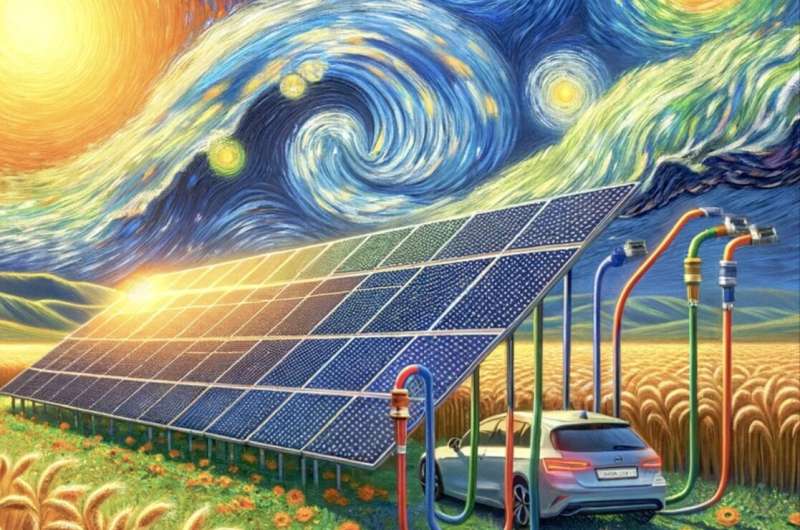February 28, 2024 dialog
This article has been reviewed according to Science X's editorial process and policies. Editors have highlighted the following attributes while ensuring the content's credibility:
fact-checked
peer-reviewed publication
trusted source
written by researcher(s)
proofread
Scalable photoelectrochemical system for solar hydrogen possible, if made from efficient all-perovskite materials

Our recent article published in Nature Energy relates our first attempt at the development of a scalable photoelectrochemical (PEC) system to produce green hydrogen.
Based on our critical review (previous review article; Chemical Society Reviews, 2019), there are challenges associated with practical solar hydrogen production. We also found that a minimum of 10% efficiency is required to develop a viable practical PEC system, for which selecting the efficient material is the first criterion.
So far, metal oxides have been studied for photocatalysis but are far away from such practical efficiency limits. On the other hand, photovoltaic (PV grade) materials (silicon, perovskites, chalcogenides, III-V class) are well established in solar cell industries. Such efficient, scalable PV-grade materials could be alternatives for PEC applications.
Very few materials fulfill the requirements for efficient PEC applications, while other materials are efficient but cannot fulfill major criteria including efficiency, low cost and integration of catalysts. The MHP materials have the excellent optoelectronic properties and tunable band-gap that are desired in the PEC field; for example, metal-halide perovskites (MHP) can provide necessary photocurrent and photovoltage to split water and produce oxygen and hydrogen in single PEC cell. Such MHP materials are also scalable at large areas including mini-modules and modules scale.
We know that there was only one challenge associated with these materials, which was the degradation of MHP in humid conditions because PEC reactions were to be conducted in liquid electrolytes. So we had to focus on stabilizing such materials using metal encapsulation or metal protection while studying the PEC reactions. With such concepts in mind, we selected the stabilized MHP material to apply in the PEC field.
Primary objectives
In our Nature Energy article, we selected the efficient material (FAPbI3 as MHP) and presented the material and thin-film analyses, applying the material in efficient photoelectrodes in PEC water splitting with at least 10% efficiency, meeting the primary objectives.
After successful experimental results, we conducted a detailed design of the experiments as a complete package, and we successfully achieved the 9.89% efficiency at small-area devices as preliminary results. Such results motivated us to check the efficacy of large-area PEC devices, and as a result, we applied such a concept to large PEC systems.
Working mechanism, underlying components, advantages, and characteristics
"Our all-perovskite PEC system comprises a FAPbI3 photoanode, which is composed of MHP thin films protected using nickel metal foil as encapsulation and NiFeOOH as catalyst layer," said Dr. Dharmesh Hansora. "We optimized this photoanode using different metal foil and studied the in-depth catalyst-electrolyte interactions. Small area FAPbI3 photoanodes (0.25 cm2) were tested using a photoanode connected to a solar cell (PEC-PV) in the single reactor system.
"As per our preliminary results, we found 9.89% (close to 10%) efficiency using small-area devices. This is because two semiconductor materials or thin-film devices are necessary to generate a maximum 2 voltage to split water molecules in O2 and H2 gas. However, the PV component has to be kept outside the reactor in the PEC-PV system.
"To minimize the system complexity, we decided to integrate both components in a single PEC device to avoid extra use of PV components, which is a unique advantage of our system, and it can reduce the cost of the system."
Main findings and uniqueness
- As stated above, the unique advantage of our system is integrating multiple components in a single PEC device to avoid extra use of PV components, which minimizes the system complexity and reduces the cost of the system.
- Another main finding is maintaining a similar performance at scalable PEC systems.
- Such short-term demonstration of scalable systems will lead to the practical application of PEC technology for green hydrogen production in outdoor conditions.
Future research and development in this area
There is room for further improvement in the efficiency and stability of the PEC system by the integration of photoelectrodes, for example, "photoanode-photocathode together, selecting a more efficient and durable catalyst," said Dr. Dharmesh Hansora.
This story is part of Science X Dialog, where researchers can report findings from their published research articles. Visit this page for information about ScienceX Dialog and how to participate.
More information: Dharmesh Hansora et al, All-perovskite-based unassisted photoelectrochemical water splitting system for efficient, stable and scalable solar hydrogen production, Nature Energy (2024). DOI: 10.1038/s41560-023-01438-x
Dr. Dharmesh Hansora is a Postdoc researcher. In 2023, He completed his Ph.D. under the supervision of Professor Jae Sung Lee in the ECOCAT laboratory at Ulsan National Institute of Science and Technology (UNIST), South Korea. He has contributed scientifically to publishing important research articles, review articles, book chapters, and a book. He has also attended conferences and several research workshops. He has been active on scientific social media platforms including ResearchGate, ResearcherID, ORCID, SCOPUS, PUBLONS, Academia.edu, GoogleScholar, LinkedIn, Facebook and Twitter.



















